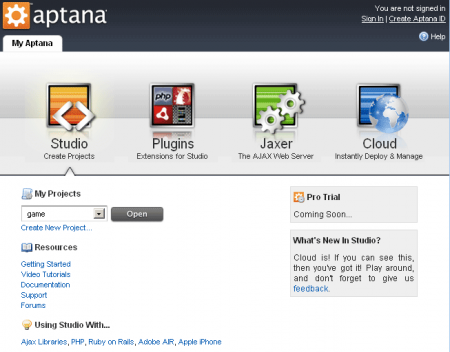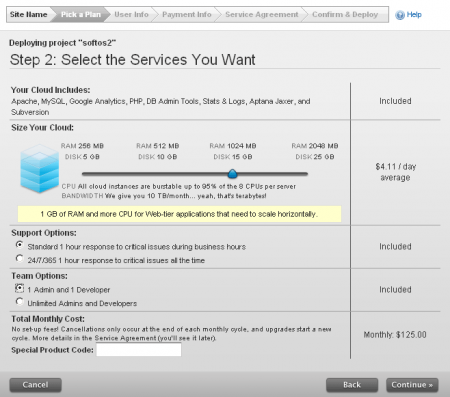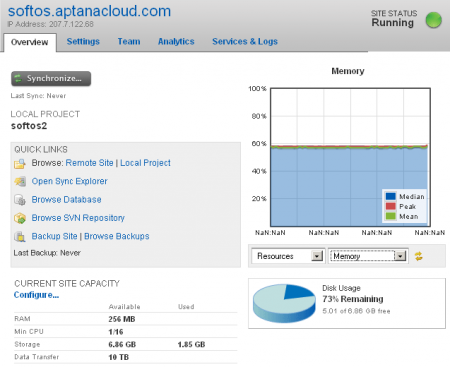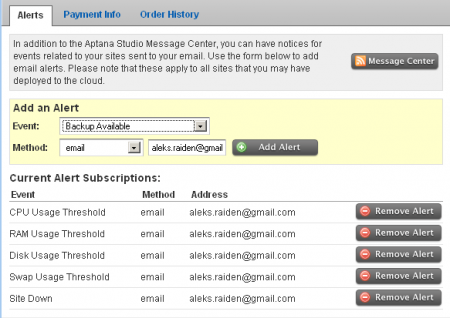Get to the skies or test your own Aptana Cloud
 Greetings to all readers. This will be an exclusive material - I received an invitation to test the latest Cloud Computing service from Aptana. Earlier, I wrote one review , but it was a free translation of a blog entry by a Western developer, now I can try all the details of this platform on my own and I’m in a hurry to share this information with you, dear readers.
Greetings to all readers. This will be an exclusive material - I received an invitation to test the latest Cloud Computing service from Aptana. Earlier, I wrote one review , but it was a free translation of a blog entry by a Western developer, now I can try all the details of this platform on my own and I’m in a hurry to share this information with you, dear readers.And so, let's get started. To get started, we need to update (or install, if not) the version of Aptana IDE . At the same time, note that the latest version is now available, even for professional subscribers, 1.1, but to work with the Cloud, you need a special release of the next version, which is available at a different address, which after registration will be sent along with your login and password for access.
After installing the update, we get Aptana IDE 1.2, and a few new items are added to the menu. First, let's see what's new in this release of the environment itself, I think after testing it will be transferred to the public branch.

')
Significantly updated control center - page Aptana Home. Now from there you can view all installed plugins, view a list of available for installation, manage the Jaxer server, if you installed it and use it. Well, the last item appeared cloud control panel.
By the way, the new version includes a client for SVN, which can be used to work with projects hosted on the Cloud. Directly from the start page, you can choose any of the projects to deploy it to the Aptana server. I have two current projects - one working, the second experimental, and it’s quite demanding of resources, so I decided to deploy it on the Aptana Cloud - this way it will be possible to test the service on typical startup solutions with a high load. At once I will make a reservation that the project uses standard technologies - PHP, part of the Zend Framework, the server side is based on ezComponents, well, the Apache web server and MySQL. The project also used PHP's Lucene search engine port (I'm just going to write about one of the following articles about it), which is the most resource-intensive component of the project, and I would like to test it.
After selecting a project, a step-by-step deployment wizard opens, which configures your cloud and transfers the project. Consider his work. The first step we are asked to choose the name of the project, which will be at the same time the address for access, the type of ProjectName.aptanacloud.com . For testing this is quite enough, but it is reported that all instances have a static address, so you can link any arbitrary domain to your project in the Cloud.

The second step is to choose your tariff plan. We are offered several plans, ranging from the youngest (256 MB RAM, 5 GB disk) and up to the largest - 2 GB RAM and 25 GB disk. All tariff plans include traffic in the amount of 10 TB per month (well, this, in principle, can be considered unlimited), as well as dynamically allocated processor power, up to 95% of the capacity of 8 processor servers (more information about server hardware is not reported). Prices are quite low, however, I think after the end of testing, they can be revised, so the specifics are not so important now. The package may also include round-the-clock support with a response time of 1 hour, regardless of time (standard - in business time) - it will be worth another 0.99 USD / day.
It is also standard that the number of users of the package includes one developer and one administrator, if you need an unlimited number of users, it will cost another 0.33 USD / day.
For testing, I tried to choose a tariff plan with 1 GB of RAM, as for good testing of serious scripts it will be just in moderation (although there is never enough memory). For the participation in the test, money is not charged yet, all testers have been given special service data of a credit card that must be entered, so you can try to “poke”. My tariff plan without additional options costs 125 USD per month, which is comparable to a more or less similar dedicated server (but without such CPU power and traffic). Oh, and here the first disappointment - for the test, only the most basic tariff plan is given. Well, then we will test this way, then, when the service is working, we will try the rest.
Next, we have to register or use an existing account, however, there is some oddity. As a user of the company's products, I should have access according to my data, since I have a professional license for Aptana IDE, but the system refused to accept the login and had to register it again - apparently there is still a separate registration there. Next, we are asked to enter credit card information and other data for billing. It’s a pity, apparently it’s not yet possible to pay with any kind of online payment systems, but for such cases you can buy a prepaid debit card once and pay with it. Unfortunately, even earlier, when I tried to buy licenses for IDE, my colleagues and I were faced with the fact that the cards issued by our banks stubbornly do not want to go through billing, so apparently this would be the best solution.
Further we agree with the license. If you take a closer look, you will find that now there is no such agreement, the standard “fish” in Latin is used - here is more about this text . Well, confirm if everything is correctly filled out. Now you can proceed to work with the cloud - the process of creating your account and setting up the necessary software in it occurs automatically after agreement and quickly enough - for several tens of seconds and everything is ready.
You can go directly to uploading your project files or go to the service control panel. We first load the project, and then explore the control panel. Deploing uses the built-in Smart Sync mechanism, but it is stated that you can use regular SVN, which is included in the list of services deployed on the site. With a sufficiently large number of files in the project there are significant brakes when synchronizing and excluding large directories with files from the list to be transferred. However, this is not a frequent procedure, so we are gaining patience. It took me several hours to complete this operation, in part because of the excessive number of components from ezComponents, which I included in the distribution, but have not yet used it.
While the project files are being sent, we will look at our hosting control panel. On the main panel we have the data of the performance and resource consumption monitor by our project, as well as the basic parameters of the tariff plan. Quick links for accessing the main functions will be useful - access to the SVN repository, file synchronization. Here you can also manage the creation of backup copies of the site. It turned out that we are given a little more space - almost 7 GB, but 1.85 GB is already occupied by one system files, so the user can use just 5 GB. It was found in the parameters that by default 1/16 CPU is available to us, apparently, if we assume that each instance runs on an 8-processor server, most likely with dual-core processors, then we get at least one core at our disposal. Not bad.

On the tab, we have access to all the same settings and selection of the tariff plan as at the start, I think this means that we can dynamically change our tariff plan without any server shutdown, which will allow the service to flex flexibly based on needs, but for now This option is not available, and manual reconfiguration is performed.
The service is initially focused on teamwork, and on the Team tab we can invite other users (by Aptana ID or simply by E-mail) and assign them roles as an administrator or developer. The admin has more authority to change the server settings and can invite other users, the developer can work with the project itself and change files, and also gets access to the deployed services.
The Google Analytics statistics service is also integrated into the control panel, but so far the module interface is very simple and it is still in development. If you already have an account with this service, you can view summary statistics on the site.

The last section of the control panel is the management of services and logs. You can enable or disable the Apache web server at any time (version 2.2.8 is used), the Jaxer application server (by the way, you can reinstall it, unlike the others) and the MySQL database server (5.0.51 is used). Here, for each service, you can view the logs, and you can both open them on a remote host using FTP or view online. Management services and work with the structure are immediately accessible to the database (DB Explorer, which is a plugin for the Aptana environment itself and Eclipse in general). For administration is available phpMyAdmin, located on the hosting. At the same time, it was discovered that for each project, another domain of the type private project_name.aptanacloud.com is created, on which, after authentication, you can get access to the database management system. On the same MySQL server there are also service monitoring databases and databases for the Jaxer server. It seems to me that such a solution in the case of high-load projects that are demanding of the database may not be the most optimal, but this requires more extensive testing and, apparently, depends on the architecture. An interesting note about RAM - in the minimum plan, you will be allocated 256 MB, of which about half will be immediately occupied - if you start Apache and MySQL (Jaxer apparently starts by default and cannot be disabled even if it is not used in the project), PHP is configured to use only 32 MB of memory.

The possibilities of notifying the administrator about all actions above the cloud are well developed. Notification by mail, SMS and jabber is supported, and the list of all actions monitored by the system is quite voluminous and contains all the necessary parameters, so you can be sure about the work of your project - in case of any problems or just significant incidents, you will be immediately informed.
What limits a little is the absence of PHP accelerators, in many projects their functionality (and not only as an accelerator) would be very useful, and it would remove the load from the servers. I think in the commercial version the list of PHP modules will be expanded, and APC or XCache will appear there.
With this, I will finish my job description with the Aptana Cloud. While the test period lasts, I will try to try my projects on this hosting, and if I have something interesting, I will definitely inform you.
I have already described my vision of the project and its perspectives in the previous article ; now I can only add that the conclusions remain valid. On the one hand, we have conditions much better than in a regular virtual hosting, but partially limited by the management and configuration of your server, so if your project requires detailed configuration of the OS and environment, you still need to take the VDS. At the same time, such hosting is more convenient because it is flexibly scalable and allows you to pay only the required amount of resources, dynamically redistributing them, and it is especially beneficial in terms of processor power and traffic, but if you are demanding to the amount of memory, a little money, you will most likely find a dedicated server (although such an offer will still need to be searched).
Source: https://habr.com/ru/post/28064/
All Articles